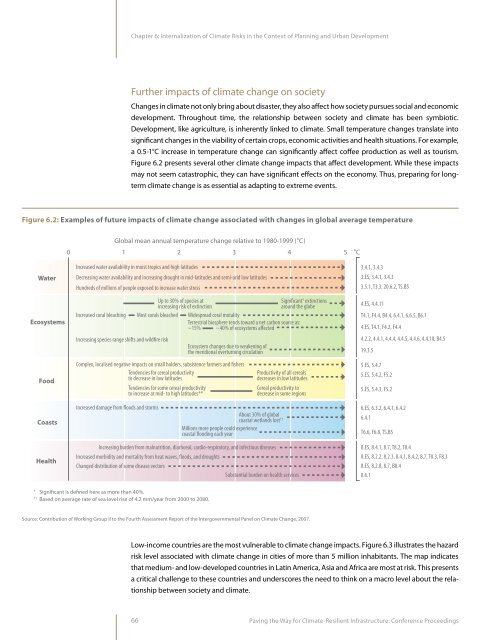Paving the Way for Climate-Resilient Infrastructure - UN CC:Learn
Paving the Way for Climate-Resilient Infrastructure - UN CC:Learn
Paving the Way for Climate-Resilient Infrastructure - UN CC:Learn
Create successful ePaper yourself
Turn your PDF publications into a flip-book with our unique Google optimized e-Paper software.
Chapter 6: Internalization of <strong>Climate</strong> Risks in <strong>the</strong> Context of Planning and Urban DevelopmentFur<strong>the</strong>r impacts of climate change on societyChanges in climate not only bring about disaster, <strong>the</strong>y also affect how society pursues social and economicdevelopment. Throughout time, <strong>the</strong> relationship between society and climate has been symbiotic.Development, like agriculture, is inherently linked to climate. Small temperature changes translate intosignificant changes in <strong>the</strong> viability of certain crops, economic activities and health situations. For example,a 0.5-1°C increase in temperature change can significantly affect coffee production as well as tourism.Figure 6.2 presents several o<strong>the</strong>r climate change impacts that affect development. While <strong>the</strong>se impactsmay not seem catastrophic, <strong>the</strong>y can have significant effects on <strong>the</strong> economy. Thus, preparing <strong>for</strong> longtermclimate change is as essential as adapting to extreme events.Figure 6.2: Examples of future impacts of climate change associated with changes in global average temperatureGlobal mean annual temperature change relative to 1980-1999 ( O C)0 1 2 3 4 5 O CWaterEcosystemsFoodIncreased water availability in moist tropics and high latitudesDecreasing water availability and increasing drought in mid-latitudes and semi-arid low latitudesHundreds of millions of people exposed to increase water stressUp to 30% of species atincreasing risk of extinctionSignificant † extinctionsaround <strong>the</strong> globeIncreased coral bleaching Most corals bleached Widespread coral motalityTerrestrial biosphere tends toward a net carbon source as:~15% ~40% of ecosystems affectedIncreasing species range shifts and wildfire riskEcosystem changes due to weakening of<strong>the</strong> meridional overturning circulationComplex, localised negative impacts on small holders, subsistence farmers and fishersTendencies <strong>for</strong> cereal productivityto decrease in low latitudesTendencies <strong>for</strong> some cereal productivityto increase at mid- to high latitudes**Productivity of all cerealsdecreases in low latitudesCereal productivity todecrease in some regions3.4.1, 3.4.33.ES, 3.4.1, 3.4.33.5.1, T3.3, 20.6.2, TS.B54.ES, 4.4.11T4.1, F4.4, B4.4, 6.4.1, 6.6.5, B6.14.ES, T4.1, F4.2, F4.44.2.2, 4.4.1, 4.4.4, 4.4.5, 4.4.6, 4.4.10, B4.519.3.55.ES, 5.4.75.ES, 5.4.2, F5.25.ES, 5.4.3, F5.2CoastsIncreased damage from floods and stormsAbout 30% of globalcoastal wetlands lost † †Millions more people could experiencecoastal flooding each year6.ES, 6.3.2, 6.4.1, 6.4.26.4.1T6.6, F6.8, TS.B5HealthIncreasing burden from malnutrition, diarhoeal, cardio-respiratory, and infectious diseasesIncreased morbidity and mortality from heat waves, floods, and droughtsChanged distribution of some disease vectorsSubstantial burden on health services8.ES, 8.4.1, 8.7, T8.2, T8.48.ES, 8.2.2, 8.2.3, 8.4.1, 8.4.2, 8.7, T8.3, F8.38.ES, 8.2.8, 8.7, B8.48.6.1†Significant is defined here as more than 40%.††Based on average rate of sea level rise of 4.2 mm/year from 2000 to 2080.Source: Contribution of Working Group II to <strong>the</strong> Fourth Assessment Report of <strong>the</strong> Intergovernmental Panel on <strong>Climate</strong> Change, 2007.Low-income countries are <strong>the</strong> most vulnerable to climate change impacts. Figure 6.3 illustrates <strong>the</strong> hazardrisk level associated with climate change in cities of more than 5 million inhabitants. The map indicatesthat medium- and low-developed countries in Latin America, Asia and Africa are most at risk. This presentsa critical challenge to <strong>the</strong>se countries and underscores <strong>the</strong> need to think on a macro level about <strong>the</strong> relationshipbetween society and climate.66<strong>Paving</strong> <strong>the</strong> <strong>Way</strong> <strong>for</strong> <strong>Climate</strong>-<strong>Resilient</strong> <strong>Infrastructure</strong>: Conference Proceedings
















